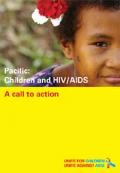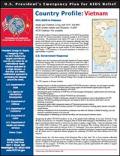What's New
Displaying results 4481 - 4490 of 4914

Resource | Publications,
HIV and AIDS have left virtually no country, rich or poor, untouched. The Pacific island countries are no exception. Fed by rapid economic and social changes, conditions have become increasingly conducive to the spread of HIV. Leaders are beginning to match words with action, and progress on prevention, testing and counselling has been made, but much more needs to be done. Children are the missing face of AIDS, and failure to take account of their critical needs for prevention, protection, treatment and care will acutely undermine the region's chance of achieving other development objectives, including the Millennium Development Goals.
HIV and AIDS are redefining the very meaning of childhood, depriving children and young people of the care, love and protection of their parents, of education and options for the future, and of protection against exploitation and abuse. All too often, children affected by HIV and AIDS are stigmatized and discriminated against or slip through social welfare systems, and those children who are already infected are missing out on vital treatment and medical care.

Resource | Publications,
I was born male and identify as one. Until recently I hadn't asked myself why I had turned out this way. Yet many transpeople I know have long asked this question of themselves. What's more, there is a small army of researchers trying to uncover answers to the same question. Relatively few seem interested in going up to a trans person and simply asking him or her 'Why do you think you turned out this way?

Resource | Publications,
On 25 October 2005, the Joint UN Programme on HIV/AIDS (UNAIDS), UNICEF and partners across the globe launched the most ambitious campaign to date to focus the world’s attention on the impact HIV and AIDS are having on children and young people today. Under the banner “Unite for Children, Unite against AIDS”, the Global Campaign on Children and AIDS sought to raise the alarm for the millions of children already living with or affected by HIV and press countries into taking action for them and future generations. For too long, children have been absent from the global HIV prevention, AIDS treatment and care agendas, and the campaign seeks to relegate these grievous omissions to the past.
This campaign could not have come at a more opportune time in East Asia and the Pacific. While HIV prevalence in the region remains relatively low, the virus poses a serious threat. East Asia’s massive population coupled with rapidly changing social and economic dynamics could escalate epidemics, and in turn, jeopardize the tremendous development gains that have greatly benefited millions of children in the region. The threat is of a different nature in the Pacific, where HIV could devastate sparse populations and undermine whole cultures and societies.

Resource | Publications,
Asia-Pacific countries have reached a critical point in their response to HIV/AIDS. Until now, levels of HIV infection in most countries have remained relatively low and the response of most governments has been similarly low-key. The region’s HIV epidemics, however, are accelerating. A million Asian and Pacific people became infected with HIV last year and more than half a million people died of AIDS. The figures will be higher in 2004.
How much worse this appalling toll becomes will depend largely on what national leaders do now. At this stage, when epidemics are still concentrated in certain population groups and geographic areas, the opportunity still exists to avert a greater disaster.

Resource | Fact Sheets,
Whilst access to treatment for tuberculosis (TB) has increased dramatically in the last ten years, not everyone has the same standard of care opportunities. Every day, thousands of TB patients are exposed to low-quality TB care. This not only causes unnecessary suffering and death, often with high costs for patients, but also damages the reputation of health facilities and health staff.
PPM encompasses diverse strategies such as Public-Private, Public-Public or Private-Private Mix that enable developing partnerships for delivery of TB care in national and local efforts to control TB. This benefi ts all the sick patient, the community, the health care provider, the TB programme, and ultimately, the health of the whole nation.

Resource | Publications,
Hong Kong locates in Asia, the new burning place of HIV infection, but still enjoying a low-prevalence of HIV infection. While sexual transmission was the predominant route of transmission in Hong Kong, an outbreak in injecting drug users was worried as taking reference from the experience in other Asian areas. Various public health measures have kept the prevalence of drug users at exceptional low level, as comparing with our neighbouring cities. This year, an increasing trend was detected in Men who have Sex with Men (MSM) in Hong Kong. The report analysed the attributes of the increase of HIV infections in MSM observed. A HIV-1 Subtype B cluster of similar gene sequencing affecting 20 individuals, mostly MSM, was firstly detected in Hong Kong. It signified the increased risk of local transmission of HIV among MSM.

Resource | Presentations,
The objectives of this presentation are to raise AIDS awareness among MSM, increase safer sexual behaviors among MSM and their sexual partners and increase access to “MSM-friendly” services for STI, VCT and HIV care and treatment.

Resource | Data Sheets,
Tables on the Matrix of the National Action Plan for HIV/AIDS and STI in Lao PDR for 5 year (2006 –2010)

Resource | Presentations,
Slides on Integration of VCCT Services into Sexual Reproductive Health Clinics. Presented by Dr. Ping Chutema, Director of Clinical Services, RHAC.

Resource | Fact Sheets,
HIV prevalence data in Vietnam is based primarily on HIV/AIDS case reporting and on the HIV Sentinel Surveillance conducted annually in 40 of Vietnam’s 64 provinces. The government now reports HIV cases in all provinces, 93 percent of all districts, and 49 percent of all communes, although many high prevalence provinces report cases in 100 percent of communes. Even though Vietnam has implemented HIV/AIDS case reporting, the general lack of HIV testing thus far suggests that the actual number of HIV infected persons is much higher. HIV prevalence in the general population is estimated to be approximately 0.4 percent.





